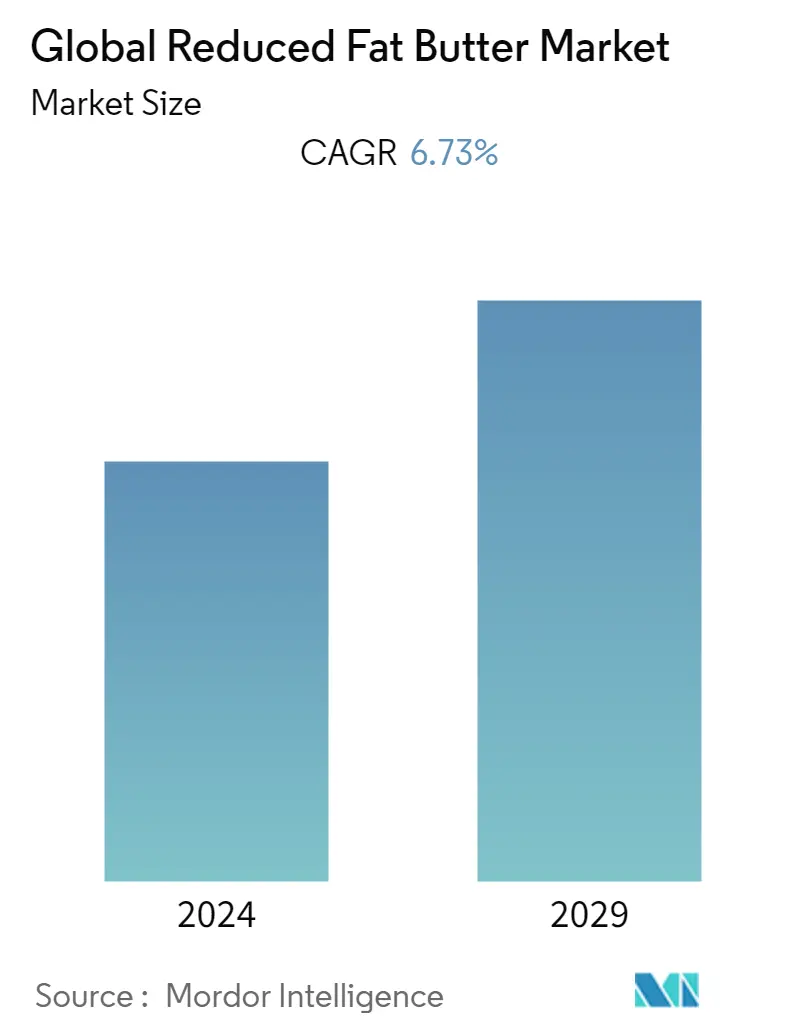Market Size of Global Reduced Fat Butter Industry

| Study Period | 2019 - 2029 |
| Base Year For Estimation | 2023 |
| Forecast Data Period | 2024 - 2029 |
| CAGR | 6.73 % |
| Fastest Growing Market | Asia Pacific |
| Largest Market | North America |
| Market Concentration | Low |
Major Players
*Disclaimer: Major Players sorted in no particular order |
Reduced Fat Butter Market Analysis
Global reduced fat butter market is projected to grow at a CAGR of 6.73% during the forecast period (2021- 2026).
- The rise in the number of health-conscious consumers has increased the demand for healthy food products acting as a key factor to boost the market growth in the next few years. Moreover, the growing incidence of obesity and cardiac arrests is also driving the product's demand. Also, companies are introducing different product forms, such as spreads and non-spreads, which is likely to contribute to the reduced-fat butter market growth.
- On the other hand, the easy availability of substitutes of reduced-fat butter such as olive oil, coconut spread, and avocado spreads which contain creamy texture & taste and offer more health benefits than reduced-fat butter may restraint the market growth during the forecast period.
- Due to COVID-19, the butter market has countered various supply chain disruptions, which also includes ingredients such as milk to produce butter, owing to which vaiorus players have switched to plant-based dairy products manufacturing, considering a better way to respond in real-time to the changing market conditions. This in turn, creates an opportunity for the market players to inovate in the category due to changing consumers preferences for healthy food products.
Reduced Fat Butter Industry Segmentation
Global reduced fat butter market is segmented by type, form, distribution channel, and geography. Based on type, the market is segmented into salted and unsalted. Based on form, the market is segmented into spreadable and non-spreadable. Based on the distribution channel, supermarkets/hypermarkets, convenience stores, online retailers, and other distribution channels. Furthermore, the report takes into consideration the market for reduced-fat butter in the established and emerging economies across the globe, including North America, Europe, Asia-Pacific, South America, Middle East & Africa.
| By Type | |
| Salted | |
| Unsalted |
| By Form | |
| Spreadable | |
| Non-spreadable |
| By Distribution Channel | |
| Supermarkets/Hypermarkets | |
| Convenience Stores | |
| Online Retailers | |
| Other Distribution Channels |
| By Geography | |||||||||
| |||||||||
| |||||||||
| |||||||||
| |||||||||
|
Global Reduced Fat Butter Market Size Summary
The global reduced fat butter market is experiencing significant growth, driven by an increasing number of health-conscious consumers seeking healthier food options. This trend is further fueled by the rising prevalence of obesity and cardiac issues, which has heightened the demand for products that offer lower fat content. Companies are responding by diversifying their product offerings, including various forms of spreads, to cater to this growing consumer base. However, the market faces challenges from the availability of healthier substitutes like olive oil and avocado spreads, which may limit the growth of reduced-fat butter. The COVID-19 pandemic has also prompted shifts in the market, with some players exploring plant-based dairy alternatives to adapt to changing consumer preferences for healthier diets.
The demand for reduced fat butter is particularly strong in developed regions such as North America, where there is a high level of consumer awareness about the benefits of a low-fat diet. This trend is expected to extend to developing economies as public health initiatives and government interventions promote healthier eating habits. The market is further bolstered by the efforts of major players like GCMMF, Land O'Lakes, Inc., and Saputo Inc., who are actively innovating and expanding their product lines to maintain a competitive edge. The Asia Pacific region is also emerging as a key market, driven by rising demand and improved living standards that encourage healthier dietary choices. The combination of product innovation, consumer awareness, and strategic market positioning is expected to sustain the growth of the reduced fat butter market in the coming years.
Global Reduced Fat Butter Market Size - Table of Contents
-
1. MARKET DYNAMICS
-
1.1 Market Drivers
-
1.2 Market Restraints
-
1.3 Porter's Five Forces Analysis
-
1.3.1 Threat of New Entrants
-
1.3.2 Bargaining Power of Buyers/Consumers
-
1.3.3 Bargaining Power of Suppliers
-
1.3.4 Threat of Substitute Products
-
1.3.5 Intensity of Competitive Rivalry
-
-
-
2. MARKET SEGMENTATION
-
2.1 By Type
-
2.1.1 Salted
-
2.1.2 Unsalted
-
-
2.2 By Form
-
2.2.1 Spreadable
-
2.2.2 Non-spreadable
-
-
2.3 By Distribution Channel
-
2.3.1 Supermarkets/Hypermarkets
-
2.3.2 Convenience Stores
-
2.3.3 Online Retailers
-
2.3.4 Other Distribution Channels
-
-
2.4 By Geography
-
2.4.1 North America
-
2.4.1.1 United States
-
2.4.1.2 Canada
-
2.4.1.3 Mexico
-
2.4.1.4 Rest of North America
-
-
2.4.2 Europe
-
2.4.2.1 Spain
-
2.4.2.2 United Kingdom
-
2.4.2.3 Germany
-
2.4.2.4 France
-
2.4.2.5 Italy
-
2.4.2.6 Russia
-
2.4.2.7 Rest of Europe
-
-
2.4.3 Asia Pacific
-
2.4.3.1 China
-
2.4.3.2 Japan
-
2.4.3.3 India
-
2.4.3.4 Australia
-
2.4.3.5 Rest of Asia-Pacific
-
-
2.4.4 South America
-
2.4.4.1 Brazil
-
2.4.4.2 Argentina
-
2.4.4.3 Rest of South America
-
-
2.4.5 Middle East and Africa
-
2.4.5.1 South Africa
-
2.4.5.2 Saudi Arabia
-
2.4.5.3 Rest of Middle East and Africa
-
-
-
Global Reduced Fat Butter Market Size FAQs
What is the current Global Reduced Fat Butter Market size?
The Global Reduced Fat Butter Market is projected to register a CAGR of 6.73% during the forecast period (2025-2030)
Who are the key players in Global Reduced Fat Butter Market?
GCMMF, Land O’Lakes, Inc, Finlandia Cheese, Inc, SAVENCIA SA and Saputo Inc. are the major companies operating in the Global Reduced Fat Butter Market.

